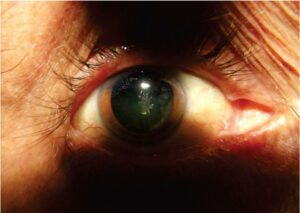Christmas tree cataract is a condition that affects the eyes and can cause blurry vision or even blindness. In this blog post, we will discuss what Christmas tree cataract is, how it is treated, and what you can do to prevent them from happening to you. So keep your reading on!
Contents
What Is A Christmas Tree Cataract?
 Christmas tree cataract is a type of cataract that affects the eye. It consists of small white dots arranged in a pattern resembling a Christmas tree, hence its name. The dots are semi-transparent and can form a cloudy haze within the lens that obstructs vision. This condition may affect one or both eyes, and it can lead to a loss of vision if left untreated.
Christmas tree cataract is a type of cataract that affects the eye. It consists of small white dots arranged in a pattern resembling a Christmas tree, hence its name. The dots are semi-transparent and can form a cloudy haze within the lens that obstructs vision. This condition may affect one or both eyes, and it can lead to a loss of vision if left untreated.
These cataracts are rare and occur when age-related changes cause proteins to break down at an accelerated rate due to elevated calcium levels. Many people don’t experience any symptoms of this condition until it has progressed to a more serious stage.
How Does Christmas Tree Cataract Develop?
This type of cataract is age-related and usually develops in people over 65. It is caused by the accumulation of protein deposits within the eye lens that form crystal-like structures, resembling a Christmas tree. The accurate cause or reason is not yet known, so the condition is still a bit of a mystery. It has been linked to diabetes, steroid medications, and ultraviolet light exposure.
It is estimated that Christmas tree cataracts affect about one in every 100 people over the age of 65 and it is more common in women. If you are experiencing symptoms of this condition, it is important to visit your eye doctor for a proper diagnosis as soon as possible.
What Are the Symptoms?
There are various symptoms of this condition. Some of the most common signs are:
- Blurred vision
- Poor night vision
- Glare from lights
- Halos around lights
- Double vision
- Difficulty recognizing faces
In addition to these symptoms, some people may also experience more severe symptoms such as:
- Difficulty reading or focusing on near objects
- Unusual sensitivity to light
- Seeing images in a distorted way
All in all, if you experience any of the above symptoms, it is important to consult your eye doctor as soon as possible. With the right treatment, you can reduce the severity of these symptoms and enjoy better vision.
What Causes Christmas Tree Cataract?
 While the exact cause of Christmas tree cataracts is unknown, there are some factors that may contribute to its development. These risk factors include:
While the exact cause of Christmas tree cataracts is unknown, there are some factors that may contribute to its development. These risk factors include:
- Advanced age: It is more common to develop cataracts as you get older.
- Exposure to UV radiation: Prolonged exposure to UV radiation, such as sunlight, is linked to a higher risk of developing cataracts.
- Genetics: People with a family history of this type of cataract are more likely to develop the condition.
- Chronic eye rubbing or irritation: When you rub or scratch your eyes, it can damage the lens and make it more likely for cataracts to form.
- Diabetes: People with diabetes are at an increased risk of developing cataracts.
- Eye trauma: An eye injury may increase your chance of developing this type of cataract.
These risks are not conclusive, and more research is needed to determine the exact cause of Christmas tree cataracts. However, you should be aware of these risk factors to lower your chances of developing them. With an understanding of how these cataracts develop, you can better understand how to treat them.
How Can Christmas Tree Cataracts Be Treated?
Some of the common treatment options for this condition include:
Eyeglasses
To help improve vision and reduce the severity of symptoms, your doctor may prescribe eyeglasses with a tinted lens. This helps to reduce glare and increase contrast while you’re going about your daily activities. For example, if you’re having difficulty reading or driving, a tinted lens can help.
Contact Lenses
If eyeglasses don’t provide enough relief, your doctor may recommend contact lenses. These lenses can be customized to fit the shape of your eye and provide the exact amount of correction necessary to give you the best possible vision.
Surgery
If your vision is significantly impaired due to this cataract, your doctor may recommend surgery. The procedure involves removing the affected lens and replacing it with an artificial intraocular lens (IOL). The process of surgery is quite safe, and the results are usually permanent.
In some cases, it may be necessary to combine treatment options for the best results. For example, your doctor may suggest wearing eyeglasses and contact lenses together to get the best possible vision.
Medications
In some cases, medications like anti-inflammatory drugs or steroids can be used to help reduce inflammation and improve vision. This can be used in mild cases of Christmas tree cataracts, but it’s not typically a long-term solution. It may be combined with other treatments, such as laser therapy, to get the best outcomes.
Lifestyle changes
Finally, if you are diagnosed with mild cataracts, then lifestyle changes can help you to manage the condition. These include:
- Regular eye check-ups
- Wearing UV protective sunglasses
- Avoiding direct sunlight for prolonged periods of time
- Eating foods that are high in antioxidants, such as fruit and vegetables
- Quitting smoking if you’re a smoker
- Taking driving safety precautions, such as wearing sunglasses when driving at night
- Regular exercise and a healthy diet to keep your eyes healthy
Overall, these things can help to slow down the progression of Christmas tree cataracts and prevent further damage. However, if symptoms become severe or vision becomes significantly impaired, then surgery may be the best option.
Just be sure to talk to your eye doctor about the best way to manage Christmas tree cataracts and what treatment options are available. With regular care and a healthy lifestyle, you can keep your vision strong and clear for years to come.
Can Christmas Tree Cataracts Be Cured Permanently?
 Many people want to know if Christmas Tree Cataracts can be cured permanently. The answer is yes, if treated correctly and on time these cataracts can indeed be removed surgically and permanently.
Many people want to know if Christmas Tree Cataracts can be cured permanently. The answer is yes, if treated correctly and on time these cataracts can indeed be removed surgically and permanently.
This is a condition that affects the eye’s lens where whitish-gray spots start appearing in a starburst pattern. The cure for this condition lies in the removal of these spots. For example, surgery is one of the most effective treatments for this condition.
During the surgery, which is called phacoemulsification, a device called an ultrasound is used to break up and remove the cataract from the lens. This procedure can be done in a very safe manner with minimal risk of infection or other complications. Afterward, your eye doctor will likely prescribe protective eyewear to protect your eyes from UV rays.
Overall, it is possible to cure Christmas Tree Cataracts permanently. However, it is important to note that this kind of cataract can be prevented through regular eye exams and healthy lifestyle habits!
Conclusion
To conclude, Christmas tree cataracts might not be a life-threatening condition but it can lead to serious vision impairment if left untreated. If you are experiencing symptoms of this condition, it is important that you seek medical treatment right away. There are various treatments available for this condition, such as surgery and eye drops, that can help you manage the condition and restore your vision.
Therefore, it is important to take the necessary steps to treat it immediately. You should always consult with a qualified medical professional before undergoing any treatment. Don’t wait any longer to get the help you need and start treating your condition today.
Cataract surgery is a safe and painless procedure. At MantraCare we have a team of experienced eye surgeons, who will be happy to answer any questions on cataract surgery. Call us at +91-9711116605 for any inquiries.
